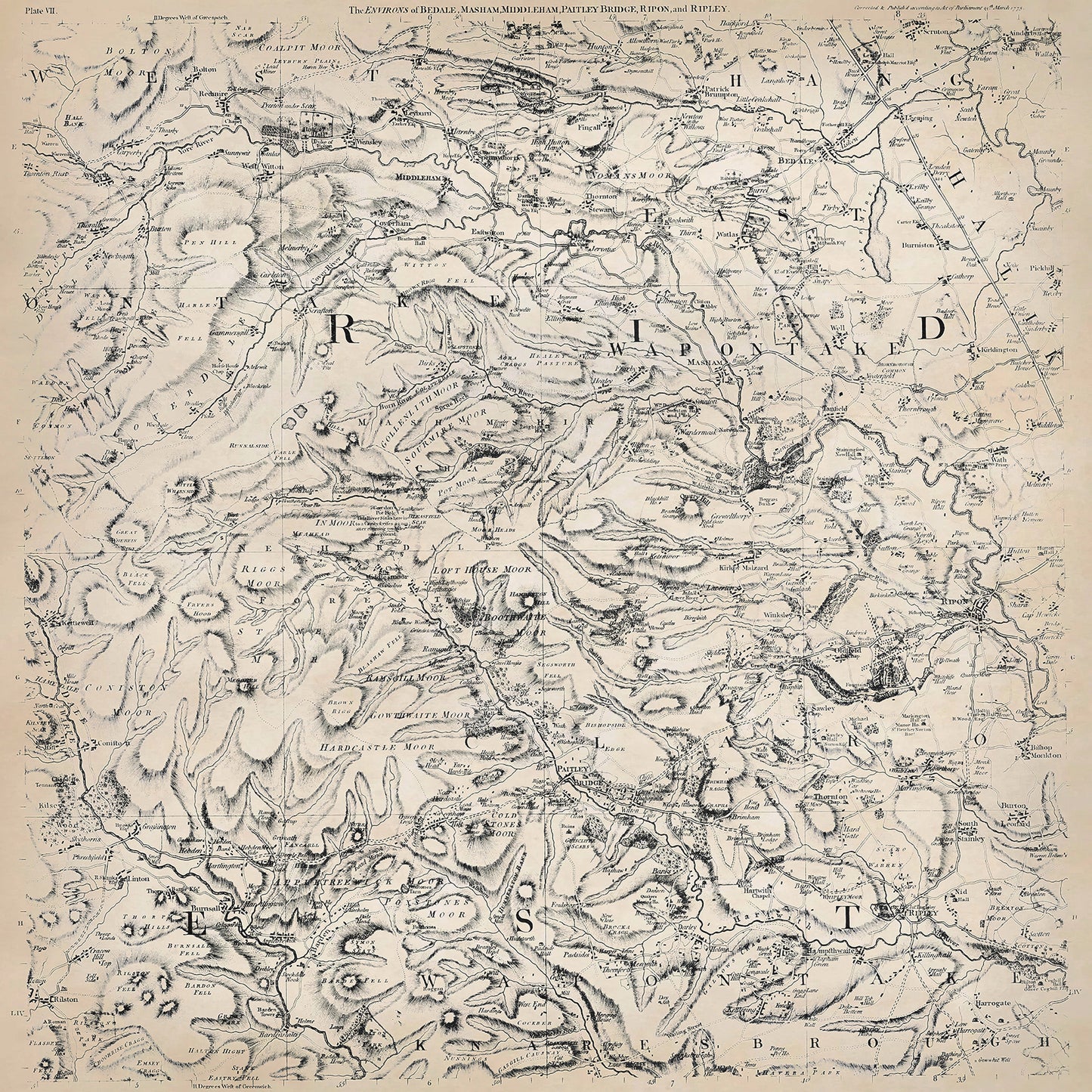Elite Wall Decor
Yorkshire in 1771 sheet 2-2 - shows the Bedale, Masham, Middleham, Paitley Bridge, Ripon and Ripley area
Yorkshire in 1771 sheet 2-2 - shows the Bedale, Masham, Middleham, Paitley Bridge, Ripon and Ripley area
Couldn't load pickup availability
Downloading this large file to phones or tablets is not recommended
This digital download is a high-quality 300dpi JPG image of one sheet from Thomas Jefferys "The County of York Survey'd" published in 1771. The image is crisp, clear and easy to read. It measures 60 x 60 cm, or 7087 x 7087 pixels but can be cropped or resized with the appropriate software. Download now to print whole or in part at home, or simply view it in close up on your device using image software such as Adobe Photoshop, Gimp, Windows Photo, or similar.
Bedale:
Bedale is a market town located in North Yorkshire, known for its historic buildings and agricultural surroundings.
Agriculture was the primary occupation in Bedale and its surrounding areas. Farmers cultivated crops such as wheat, barley, oats, and vegetables. The town was known for its sheep farming, with farmers rearing flocks of Swaledale and Wensleydale sheep.
Bedale had limited industrial activity during this period. Cottage industries were common, with some residents involved in spinning wool and producing textiles. Additionally, the town's market provided employment for traders, merchants, and craftsmen.
Bedale Hall, a historic manor house, was a notable landmark in the town. The hall and its gardens were of architectural and historical significance.
Masham:
Masham is a small market town situated on the banks of the River Ure in North Yorkshire. It is known for its brewing heritage and historic buildings.
Agriculture was the predominant occupation in Masham and its environs. Farmers cultivated crops such as barley, oats, and hay. The town's fertile land supported sheep farming as well.
Masham was renowned for its brewing industry during this period. The town had several breweries that produced ales and beers, utilizing local ingredients such as barley and hops. The brewing industry created employment opportunities for brewers, maltsters, coopers, and other brewery workers.
Masham had a picturesque market square surrounded by historic buildings, including the town hall.
Middleham:
Middleham is a small market town located in Wensleydale, known for its historic castle and horse racing heritage.
Agriculture was the primary occupation in Middleham and its surrounding areas. Farmers cultivated crops such as barley, oats, and hay. The town's open fields and pastures supported sheep farming.
Middleham Castle, dating back to the 12th century, was a prominent feature of the town. It served as the residence of prominent medieval figures, including Richard III. The castle's ruins and architectural features attracted visitors interested in history and heritage.
Pateley Bridge:
Pateley Bridge is a historic market town located in Nidderdale, North Yorkshire. It is known for its scenic beauty, location in the Yorkshire Dales, and charming buildings.
Agriculture was the primary occupation in Pateley Bridge and its surrounding areas. Farmers cultivated crops such as oats, barley, and hay. The town's rural landscape supported sheep farming.
Pateley Bridge had limited industrial activity during the late 18th century. Cottage industries were prevalent, with some residents engaged in spinning wool and producing textiles. There were also small-scale craft industries, such as pottery and basket weaving.
Pateley Bridge had a vibrant market that attracted traders and visitors from surrounding areas.
Ripon:
Ripon is a historic cathedral city located in North Yorkshire. It has a rich history dating back to Roman times and is known for its cathedral and market square.
Agriculture played a significant role in Ripon's economy during the late 18th century. Farmers cultivated crops such as wheat, barley, oats, and vegetables. The surrounding countryside supported sheep farming as well.
Ripon had a few notable industries during this period. The city was known for its brewing industry, with several breweries producing ales and beers. Other industries included tanning and leatherworking, which employed workers skilled in processing hides and producing leather goods.
Ripon Cathedral, also known as the Cathedral Church of St. Peter and St. Wilfrid, was a prominent landmark in the city. The cathedral's stunning architecture and rich history made it a popular attraction for tourists and locals alike. The city also had a bustling market square.
Ripley:
Ripley is a small village located in North Yorkshire, known for its historic castle and picturesque setting.
Agriculture was the main occupation in Ripley and its surrounding areas. Farmers cultivated crops such as wheat, barley, oats, and vegetables. The village's countryside supported sheep farming.
Ripley had limited industrial activity during the late 18th century. Cottage industries were prevalent, with some residents involved in spinning wool and producing textiles. The village also had a few craftsmen engaged in carpentry, blacksmithing, and other skilled trades.
Ripley Castle, dating back to the 14th century, was a significant attraction in the village. The castle and its surrounding gardens were of architectural and historical importance.

